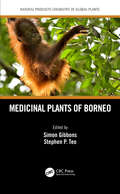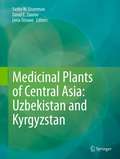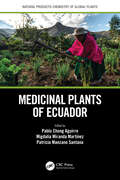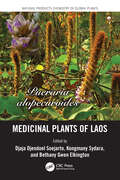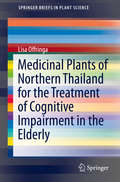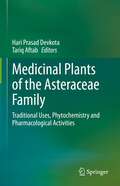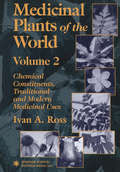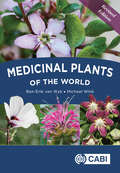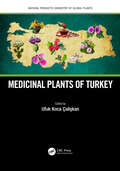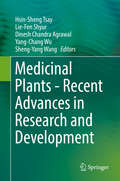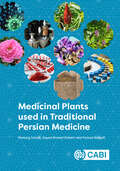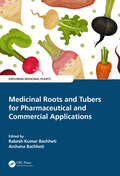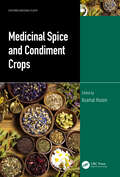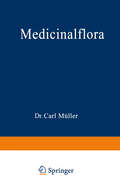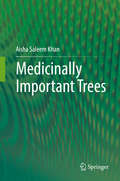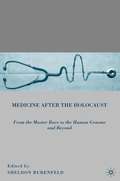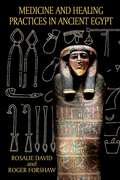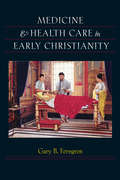- Table View
- List View
Medicinal Plants of Borneo (Natural Products Chemistry of Global Plants)
by Simon Gibbons Stephen P. TeoThe rich biodiversity of Borneo provides many useful plants for medicinal purposes. Written by experts in the field, Medicinal Plants of Borneo provides a guide and introduction to the medicinal plants from Borneo used traditionally as well as plants whose medicinal uses have been recently discovered. These include anti-HIV plants – such as Calophyllum lanigerum (calanolide A) – and anti-cancer plants – such as Aglaia foveolata (silvestrol). The book also provides information on the relevant medicinal chemistry, such as isolated bioactive compounds and the mechanism of action, where available. FEATURES Discusses the rich experience in the use of medicinal plants and the wide diversity of Borneo’s botanical resources Presents plants with medicinal properties from a scientific perspective Provides readers with current information on the chemistry and pharmacology of natural products with pharmaceutical potential Covers a range of chemical, botanical and pharmacological diversities Forms an important part of the Natural Products Chemistry of Global Plants series due to an increasing global interest in natural products and botanical drugs Simon Gibbons is Head of the School of Pharmacy, University of East Anglia, UK, and a Professor of Natural Product Chemistry. He was formerly a Professor of Medicinal Phytochemistry at the School of Pharmacy, University College London (UCL). Stephen P. Teo is a forest botanist with the Forest Department, Sarawak, Malaysia.
Medicinal Plants of Central Asia: Uzbekistan and Kyrgyzstan
by Sasha W. Eisenman, David E. Zaurov and Lena StruweThis unique book is a collaborative effort between researchers at Rutgers University and colleagues from numerous institutions in Uzbekistan and Kyrgyzstan. It will be the first book to document more than 200 of the most important medicinal plants of Central Asia, many whose medicinal uses and activities are being described in English for the first time. The majority of the plants described grow wild in Central Asia with some being endemic, while other species have been introduced to Central Asia but are commonly used in regional plant based medicine. The book contains four introductory chapters. The first and second chapters cover the geography, climate and vegetation of Kyrgyzstan and Uzbekistan, respectively. The third chapter provides a brief history of medicinal plant use and science in Central Asia and the fourth chapter contains general information about phytochemistry. The fifth chapter comprises the bulk of the book and covers 208 medicinal plant species. Nearly all species have one or more high quality, color photographs. Three useful appendices have been included. The first is a glossary of botanical and ecological terms, the second is a glossary of chemistry terms and the third is a glossary of medical terms. During the preparation of this manuscript we found there to be a deficiency in quality reference resources for the translation of many of the technical terms associated with the different branches of science covered in this book. In order to make our job easier we compiled glossaries over the course of preparing the manuscript and have included them feeling that they will be an extremely valuable resource for readers.
Medicinal Plants of Ecuador (Natural Products Chemistry of Global Plants)
by Pablo Chong Aguirre Migdalia Miranda Martínez Patricia Manzano SantanaThis unique volume draws on the rich culture, folklore and environment of medicinal plants in Ecuador, which includes the important rain forest region. This country has rich plant resources and a large diversity of plants. In particular, the Biotechnological Research Center of Ecuador, CIBE, is an important center of plant research and biodiversity. For more than 16 years, CIBE has been performing scientific research on plants and microorganisms with extensive focus on biodiversity, biotechnology, bioproducts, hytopathology, molecular biology, tissue culture and technology transfer. The Center has state-of-the-art infrastructure and technology and a great strength in human resources.
Medicinal Plants of Ecuador (Natural Products Chemistry of Global Plants)
by Pablo Chong Aguirre Migdalia Miranda Martínez Patricia Manzano SantanaThis unique volume draws on the rich culture, folklore and environment of medicinal plants in Ecuador, which includes the important rain forest region. This country has rich plant resources and a large diversity of plants. In particular, the Biotechnological Research Center of Ecuador, CIBE, is an important center of plant research and biodiversity. For more than 16 years, CIBE has been performing scientific research on plants and microorganisms with extensive focus on biodiversity, biotechnology, bioproducts, hytopathology, molecular biology, tissue culture and technology transfer. The Center has state-of-the-art infrastructure and technology and a great strength in human resources.
Medicinal Plants of Laos (Natural Products Chemistry of Global Plants)
by Djaja Djendoel Soejarto Bethany G. Elkington Kongmany SydaraThis book provides a description of medicinal plants of Laos, including their role in maintaining healthcare among the population, their potential as a source for new medicinal compounds, their preservation, and their importance for the well-being of the communities for present and future generations. The focus of this book is to draw on the rich culture, folklore, and environment of medicinal plants in the country. This is an opportunity to describe medicinal plants from a scientifically underrepresented area, with the hope of making an important contribution to the knowledge of the region for academics, scientists, and anyone who has interest in Laos. Features Describes terrestrial medicinal plants from a scientifically underrepresented region. Includes a wider variety of plants found growing in Laos than has previously been published. Discusses past and present research on medicinal plants that may lead to the discovery of new medicines. Describes efforts in the preservation of these medicinal plants for present and future generations. Focuses on the rich culture, folklore, and environment of medicinal plant in Laos. Provides an important contribution to knowledge of the region and will benefit anyone interested in the medicinal plants of Laos.
Medicinal Plants of Laos (Natural Products Chemistry of Global Plants)
by Djaja Djendoel Soejarto Kongmany Sydara Bethany Gwen ElkingtonThis book provides a description of medicinal plants of Laos, including their role in maintaining healthcare among the population, their potential as a source for new medicinal compounds, their preservation, and their importance for the well-being of the communities for present and future generations. The focus of this book is to draw on the rich culture, folklore, and environment of medicinal plants in the country. This is an opportunity to describe medicinal plants from a scientifically underrepresented area, with the hope of making an important contribution to the knowledge of the region for academics, scientists, and anyone who has interest in Laos. Features Describes terrestrial medicinal plants from a scientifically underrepresented region. Includes a wider variety of plants found growing in Laos than has previously been published. Discusses past and present research on medicinal plants that may lead to the discovery of new medicines. Describes efforts in the preservation of these medicinal plants for present and future generations. Focuses on the rich culture, folklore, and environment of medicinal plant in Laos. Provides an important contribution to knowledge of the region and will benefit anyone interested in the medicinal plants of Laos.
Medicinal Plants of Northern Thailand for the Treatment of Cognitive Impairment in the Elderly (SpringerBriefs in Plant Science)
by Lisa OffringaThis book provides a description of cognitive impairment in the elderly population through the lens of Thai Traditional Medicine as it is practiced in northern Thailand. It provides an overview of Thai Traditional Medicine and the memory loss presented in elderly dementia. Some medicinal plants used by traditional Thai healers to treat cognitive decline and memory issues in the elderly are reviewed.Medicinal Plants of Northern Thailand for the Treatment of Cognitive Impairment in the Elderly provides readers with the detailed description of the in vitro screening of ten plants and those results. The bioactivity of these single plants exemplifies the success of using an ethnobotanical filter to identify plants with cognitive enhancing activity.
Medicinal Plants of the Asteraceae Family: Traditional Uses, Phytochemistry and Pharmacological Activities
by Hari Prasad Devkota Tariq AftabThis book highlights 12 major plants in the Asteraceae family from the aspects of traditional uses as food and medicine, phytochemistry, and pharmacological activities. Asteraceae is one of the largest family of flowering plants comprising over 1,600 plant genera and 32,000 plant species. Plants belonging to this family have a long history of being used as medicinal plants for the treatment of various diseases. Many of them are also used in the preparation of foods, beverages, and also used in pharmaceutical and cosmetic industries. In addition, plants such as Artemisia annua have played an important role in the discovery of novel drugs. The book summarizes the traditional uses of the plants in the family Asteraceae and their scientific validation, which helps readers understand their relation and impact on human health. It also explains the Phytochemistry of the species and presents the pharmacological activities and mechanisms in detail. Understanding current scientific knowledge will help in the commercialization of products based on these plants and also helps to find the research gaps that should be fulfilled in the future for their optimal use. It also helps in increasing the awareness of the plant species related to conservation, cultivation, and sustainable utilization. This edited volume comprises chapters contributed by experts from around the world.
Medicinal Plants of the World: Chemical Constituents, Traditional and Modern Medicinal Uses, Volume 2
by Ivan A. RossAn extraordinary compendium of information on herbal medicine, Medicinal Plants of the World, Volume 2 comprehensively documents the medicinal value of twenty-four major plants species widely used around the world in medical formulations. The book's exhaustive summary of available scientific data for the plants provides detailed information on how each plant is used in different countries, describing both traditional therapeutic applications and what is known from its use in clinical trials. A comprehensive bibliography of over 3000 references cites the literature available from a wide range of disciplines. This book offers an unprecedented collection of vital scientific information for pharmacologists, herbal medicine practitioners, drug developers, medicinal chemists, phytochemists, toxicologists, and researchers who want to explore the use of plant materials for medicinal and related purposes.
Medicinal Plants of the World
by Ben-Erik van Wyk Professor Michael WinkMedicinal plants and plant-derived medicine are widely used in traditional cultures all over the world and they are becoming increasingly popular in modern society as natural alternatives to synthetic chemicals. As more and more natural remedies are being commercialised, there is a need for a user-friendly reference guide to the plants and their products. The book gives the reader a bird's eye view of more than 350 of the best known medicinal plants of the world and their uses, in a compact, colourful and scientifically accurate reference text. It provides quick answers to the most obvious questions: Where does this plant originate? What does it look like? In which culture is it traditionally used? What is it used for? Which chemical compounds does it contain? How safe is it? What is known about its pharmacological activity? What evidence is there that it is effective? The authors also provide short overviews of the various health conditions for which medicinal plants are used and the active compounds (secondary metabolites) found in the plants and their modes of actions. This new edition has an additional 30 plant species, many new and improved photographs and the text has been fully updated to reflect the latest regulatory status of each plant.
Medicinal Plants of Turkey (Natural Products Chemistry of Global Plants)
by Ufuk Koca CaliskanThis book is part of the book series titled Natural Products Chemistry of Global Plants, and examines the rich plant diversity of Turkey, with descriptions of the plants and pharmacognosy properties. There is a focus on the chemistry of natural products and areas rich in folklore and botanical medicinal uses are covered with a particular interest in the region of Anatolia. This book focuses on the chemistry of the natural products, and where possible links these molecules to pharmacological modes of action. Students and professionals interested in the ethnobotany, chemistry, pharmacology and biological activites of species used medicinally in Turkey will benefit from this book. Features Addresses the rich chemistry of the natural products and their respective biosynthetic building blocks Includes the association that many of the extracts have today with important drugs, nutrition products, beverages, perfumes, cosmetics and pigments Describes the key natural products and their extracts, with emphasis on sources, their complex molecules and applications in science Fills a gap in our understanding of medicinal plants, specifically in Turkey Provides an in-depth understanding of medicinal plants from Turkey, and their complex chemistry and structures
Medicinal Plants of Turkey (Natural Products Chemistry of Global Plants)
by Ufuk Koca ÇalışkanThis book is part of the book series titled Natural Products Chemistry of Global Plants, and examines the rich plant diversity of Turkey, with descriptions of the plants and pharmacognosy properties. There is a focus on the chemistry of natural products and areas rich in folklore and botanical medicinal uses are covered with a particular interest in the region of Anatolia. This book focuses on the chemistry of the natural products, and where possible links these molecules to pharmacological modes of action. Students and professionals interested in the ethnobotany, chemistry, pharmacology and biological activites of species used medicinally in Turkey will benefit from this book. Features Addresses the rich chemistry of the natural products and their respective biosynthetic building blocks Includes the association that many of the extracts have today with important drugs, nutrition products, beverages, perfumes, cosmetics and pigments Describes the key natural products and their extracts, with emphasis on sources, their complex molecules and applications in science Fills a gap in our understanding of medicinal plants, specifically in Turkey Provides an in-depth understanding of medicinal plants from Turkey, and their complex chemistry and structures
Medicinal Plants - Recent Advances in Research and Development (Medicinal And Aromatic Plants Of The World Ser. #4)
by Hsin-Sheng Tsay Lie-Fen Shyur Dinesh Chandra Agrawal Yang-Chang Wu Sheng-Yang WangSince ancient times, plants have been used as a prime natural source of alternative medicines and have played an important role in our lives. The old tradition of medicinal plant application has turned into a highly profitable business in the global market, resulting in the release of a large number of herbal products. People have tried to find different sources of medicines to alleviate pain and cure different illnesses. Due to severe constraints of synthetic drugs and the increasing contraindications of their usage, there is a growing interest world over in the usage of natural products based on medicinal herbs, hence, there is an ever expanding market of herbs and herbal based medicinal preparations all over the world. This has culminated into an exponential increase in number of research groups in different geographical locations and generation of volume of research data in the field in a short span of time. The path breaking advancement in research methods and interdisciplinary approaches is giving birth to newer perspectives. Therefore, it becomes imperative to keep pace with the advancement in research and development in the field of medicinal herbs. There are a large number of researchers in different parts of the world working on various aspects of medicinal plants and ‘herbal medicines’. The idea is to bring their recent research work into light in the form of a book. The proposed book contains chapters by the eminent researchers in different countries and working with different disciplines of medicinal plants. Articles pertain to different disciplines such as: 1. Resources and conservation of medicinal plants 2. Biosynthesis and metabolic engineering of medicinal plants 3. Tissue culture, propagation and bioreactor technology of medicinal plants 4. Phytochemical research on medicinal plants 5. Herbal medicines and plant-derived agents in cancer prevention and therapy 6. Herbal medicines and plant-derived agents in metabolic syndrome management 7. Herbal medicines and plant-derived agents in modulation of immune-related disorders 8. Herbal medicines and hepatotoxicity The book will prove itself an asset for the researchers, professionals and also students in the area of medicinal plants and mechanism of their action.
Medicinal Plants used in Traditional Persian Medicine
by Mamak Hashemi Abadi Maryam Akabery Seyyed Ahmad Askari Sayyedeh Fatemeh Askari Zahra Ayati Sajad Azad Parmis Badr Hamed Baharara Zahra Boghrati Mina Borhani Fatemeh Etemadpour Seyed Majid Ghazanfari Shakila Hajizadeh Bahia Namavar Jahromi Lida Jarahi Mohammad Reza Kanani Seyedeh Mahnaz Karimi Abdolali Mohagheghzadeh Leila Mohtashami Ghazaleh Mosleh Nayebzadeh Motahare Maryam Nikoosokhan Roja Rahimi Zahra Taghipour Mojgan Tansaz Meysam Zaeri Elaheh Zibaee Roodabeh Bahramsoltani Amir Hossein AbdolghaffariMedicinal plants and the natural products within them, still remain the starting point for breakthroughs in the development of safe, pharmacologically active synthetic molecules for use in a wide variety of clinical situations. Traditional Persian Medicine (TPM) is one of the most ancient medical doctrines, and is well-documented in terms of information about diseases, diagnoses and treatments, especially in the application of medicinal plants. TPM has been used for centuries worldwide, and many of these methods are still used in Iran today. The book introduces the basics of TPM, and describes the key medicinal plants used for the treatment of different diseases. It also highlights possible new targets for research activities in drug discovery of natural products. The book is richly illustrated with historic drawings from old Persian pharmacopoeia and photos of plants in their natural habitats. Reference to Ayurvedic, Traditional Chinese Medicine and monastic medicine in Europe are also made. While knowledge about medicinal plants used in TPM still exists in Iran there is a risk that the detailed expertise provided by older generations will be lost in the near future. It is therefore very important that this cultural heritage is properly preserved. This book provides a valuable, evidence-based resource on TPM for researchers, practitioners and students in medicinal plants, ethnobotany and herbal medicine.
Medicinal Roots and Tubers for Pharmaceutical and Commercial Applications (Exploring Medicinal Plants)
by Rakesh Kumar Bachheti and Archana BachhetiThe root and tuber are vital parts of medicinal plants providing mechanical support, producing critical growth regulators, and storing food. Bioactive compounds obtained from plant roots and tubers demonstrate health benefits presenting antioxidative, antimicrobial, hypoglycaemic, hypocholesterolaemic, and immunomodulatory properties. Roots of many medicinal plants have been used for the treatment of disease and formulation of drugs, and they are also known for their commercial value, being used as an ingredient in the pharmaceutical and cosmetic industries. Medicinal Roots and Tubers for Pharmaceutical and Commercial Applications provides information on the medicinal properties of roots and tubers and various phytochemicals derived from them. Features Presents exhaustive information on plant roots and tubers including Glycyrrhiza glabra, Curcuma longa, Beta vulgaris, Zingiber officinalis, Boesenbergia pandurata, Houttuynia cordata, Eutrema japonicum, and Withania somnifera Explains the roles of secondary metabolites isolated from roots and tubers and features information on their pharmaceutical and commercial applications Discusses opportunities for future prospects of different roots and tubers for their industrial applications A volume in the Exploring Medicinal Plants series, this book provides information on phytochemicals derived from medicinal plant roots and tubers. This is valuable information for scientists, researchers, and students working on medicinal plants, economic botany, chemistry, biotechnology, pharmaceuticals, and many other interdisciplinary subjects.
Medicinal Roots and Tubers for Pharmaceutical and Commercial Applications (Exploring Medicinal Plants)
The root and tuber are vital parts of medicinal plants providing mechanical support, producing critical growth regulators, and storing food. Bioactive compounds obtained from plant roots and tubers demonstrate health benefits presenting antioxidative, antimicrobial, hypoglycaemic, hypocholesterolaemic, and immunomodulatory properties. Roots of many medicinal plants have been used for the treatment of disease and formulation of drugs, and they are also known for their commercial value, being used as an ingredient in the pharmaceutical and cosmetic industries. Medicinal Roots and Tubers for Pharmaceutical and Commercial Applications provides information on the medicinal properties of roots and tubers and various phytochemicals derived from them. Features Presents exhaustive information on plant roots and tubers including Glycyrrhiza glabra, Curcuma longa, Beta vulgaris, Zingiber officinalis, Boesenbergia pandurata, Houttuynia cordata, Eutrema japonicum, and Withania somnifera Explains the roles of secondary metabolites isolated from roots and tubers and features information on their pharmaceutical and commercial applications Discusses opportunities for future prospects of different roots and tubers for their industrial applications A volume in the Exploring Medicinal Plants series, this book provides information on phytochemicals derived from medicinal plant roots and tubers. This is valuable information for scientists, researchers, and students working on medicinal plants, economic botany, chemistry, biotechnology, pharmaceuticals, and many other interdisciplinary subjects.
Medicinal Spice and Condiment Crops (Exploring Medicinal Plants)
by Azamal HusenSpices are used in small quantities to add flavor, aroma, color, and texture in food preparation. However, spices and condiments have also been recognized as having medicinal value. They have been used traditionally as curative and preventive agents, the bioactive compounds obtained from these plants are used in herbal drug formulations in modern times. Medicinal Spice and Condiment Crops provides a comprehensive overview on the medicinal properties of spices and condiments with focus on various phytochemicals derived from them.KEY FEATURES:• Examines spices and condiments with respect to their biology, diversity, distribution, and pharmacological values.• Explores the scientific validations of the therapeutic potentials of spice and condiment plant species.• Discusses the bioactive agents involved in alleviating symptoms of cardiovascular disease, cancer, diabetes, ulcers, skin disorders, and neurodegenerative diseases.• Explains specific medicinal features of spice and condiment-producing plant species inspiring research, discovery, and safe herbal drug formulation.A volume in the Exploring Medicinal Plants series, this book is useful for plant scientists, economic botanists, those who work with herbal and complementary medicine, as well as people working in the pharmaceutical industry.
Medicinal Spice and Condiment Crops (Exploring Medicinal Plants)
Spices are used in small quantities to add flavor, aroma, color, and texture in food preparation. However, spices and condiments have also been recognized as having medicinal value. They have been used traditionally as curative and preventive agents, the bioactive compounds obtained from these plants are used in herbal drug formulations in modern times. Medicinal Spice and Condiment Crops provides a comprehensive overview on the medicinal properties of spices and condiments with focus on various phytochemicals derived from them.KEY FEATURES:• Examines spices and condiments with respect to their biology, diversity, distribution, and pharmacological values.• Explores the scientific validations of the therapeutic potentials of spice and condiment plant species.• Discusses the bioactive agents involved in alleviating symptoms of cardiovascular disease, cancer, diabetes, ulcers, skin disorders, and neurodegenerative diseases.• Explains specific medicinal features of spice and condiment-producing plant species inspiring research, discovery, and safe herbal drug formulation.A volume in the Exploring Medicinal Plants series, this book is useful for plant scientists, economic botanists, those who work with herbal and complementary medicine, as well as people working in the pharmaceutical industry.
Medicinalflora: Eine Einführung in die allgemeine und angewandte Morphologie und Systematik der Pflanzen
by Carl MüllerMedicinally Important Trees
by Aisha Saleem KhanThis book provides researchers and advanced students associated with plant and pharmaceutical sciences with comprehensive information on medicinal trees, including their identification, morphological characteristics, traditional and economic uses, along with the latest research on their medicinal compounds.The text covers the ecological distribution of over 150 trees, which are characterized mainly on the basis of their unique properties and phytochemicals of medicinal importance (i.e., anti-allergic, anti-diabetic, anti-carcinogenic, anti-microbial, and possible anti-HIV compounds). Due to the incredibly large diversity of medicinal trees, it is not possible to cover all within one publication, so trees with unique medicinal properties that are relatively more common in many countries are discussed here in order to make it most informative for a global audience.With over 100 illustrations taken at different stages of plant development, this reference work serves as a tool for tree identification and provides morphological explanations. It includes the latest botanical research, including biochemical advancements in phytochemistry techniques such as chromatographic and spectrometric techniques. In addition, the end of each chapter presents the most up-to-date references for further sources of exploration.
Medicine after the Holocaust: From the Master Race to the Human Genome and Beyond
by S. RubenfeldRubenfeld and the contributors to this collection posit that German physicians betrayed the Hippocratic Oath when they chose knowledge over wisdom, the state over the individual, a führer over God, and personal gain over professional ethics.
Medicine and Healing Practices in Ancient Egypt
by Rosalie David Roger ForshawMedicine and Healing Practices in Ancient Egypt provides a new perspective on healthcare and healing treatments in Egypt from the Predynastic to the Roman periods. Rather than concentrating exclusively on diseases and medical conditions as evidenced in ancient sources, it provides a ‘people-focused’ perspective, asking what it was like to be ill or disabled in this society? Who were the healers? To what extent did disease occurrence and treatment reflect individual social status? As well as geographical, environmental and dietary factors, which undoubtedly affected general health, some groups were prone to specific hazards. These are discussed in detail, including soldiers’ experience of trauma, wounds and exposure to epidemics; and conditions - blindness, sand pneumoconiosis, trauma and limb amputations – resulting from working conditions at building and other sites. Methods of diagnosis and treatment were derived from special concepts about disease and medical ethics. These are explored, as well as the individual contributions and professional interactions of various groups of healers and carers. Medical training and practice occurred in various locations, including temples and battlefields; these are described, as well as the treatments and equipment that were available. Ancient writers generally praised the Egyptian healers’ knowledge, expertise, and professional relationship with their patients. A brief comparison is drawn between this approach and those prevailing elsewhere in Mesopotamia, Greece and Rome. Finally, Egypt’s legacy, transmitted through Greek, Roman and Arabic sources, is confirmed as the source of some principles and practices still found in modern ‘Western’ medicine. Combining information from the latest studies on human remains and the authors’ biomedical research, this book brings the subject up to date, enabling a wide readership to access often scattered information in a fascinating synthesis.
Medicine and Healing Practices in Ancient Egypt
by Rosalie David Roger ForshawMedicine and Healing Practices in Ancient Egypt provides a new perspective on healthcare and healing treatments in Egypt from the Predynastic to the Roman periods. Rather than concentrating exclusively on diseases and medical conditions as evidenced in ancient sources, it provides a ‘people-focused’ perspective, asking what it was like to be ill or disabled in this society? Who were the healers? To what extent did disease occurrence and treatment reflect individual social status? As well as geographical, environmental and dietary factors, which undoubtedly affected general health, some groups were prone to specific hazards. These are discussed in detail, including soldiers’ experience of trauma, wounds and exposure to epidemics; and conditions - blindness, sand pneumoconiosis, trauma and limb amputations – resulting from working conditions at building and other sites. Methods of diagnosis and treatment were derived from special concepts about disease and medical ethics. These are explored, as well as the individual contributions and professional interactions of various groups of healers and carers. Medical training and practice occurred in various locations, including temples and battlefields; these are described, as well as the treatments and equipment that were available. Ancient writers generally praised the Egyptian healers’ knowledge, expertise, and professional relationship with their patients. A brief comparison is drawn between this approach and those prevailing elsewhere in Mesopotamia, Greece and Rome. Finally, Egypt’s legacy, transmitted through Greek, Roman and Arabic sources, is confirmed as the source of some principles and practices still found in modern ‘Western’ medicine. Combining information from the latest studies on human remains and the authors’ biomedical research, this book brings the subject up to date, enabling a wide readership to access often scattered information in a fascinating synthesis.
Medicine and Healing Practices in Ancient Egypt
by Rosalie David Roger ForshawMedicine and Healing Practices in Ancient Egypt provides a new perspective on healthcare and healing treatments in Egypt from the Predynastic to the Roman periods. Rather than concentrating exclusively on diseases and medical conditions as evidenced in ancient sources, it provides a ‘people-focused’ perspective, asking what it was like to be ill or disabled in this society? Who were the healers? To what extent did disease occurrence and treatment reflect individual social status? As well as geographical, environmental and dietary factors, which undoubtedly affected general health, some groups were prone to specific hazards. These are discussed in detail, including soldiers’ experience of trauma, wounds and exposure to epidemics; and conditions - blindness, sand pneumoconiosis, trauma and limb amputations – resulting from working conditions at building and other sites. Methods of diagnosis and treatment were derived from special concepts about disease and medical ethics. These are explored, as well as the individual contributions and professional interactions of various groups of healers and carers. Medical training and practice occurred in various locations, including temples and battlefields; these are described, as well as the treatments and equipment that were available. Ancient writers generally praised the Egyptian healers’ knowledge, expertise, and professional relationship with their patients. A brief comparison is drawn between this approach and those prevailing elsewhere in Mesopotamia, Greece and Rome. Finally, Egypt’s legacy, transmitted through Greek, Roman and Arabic sources, is confirmed as the source of some principles and practices still found in modern ‘Western’ medicine. Combining information from the latest studies on human remains and the authors’ biomedical research, this book brings the subject up to date, enabling a wide readership to access often scattered information in a fascinating synthesis.
Medicine and Health Care in Early Christianity
by Gary B. FerngrenDrawing on New Testament studies and recent scholarship on the expansion of the Christian church, Gary B. Ferngren presents a comprehensive historical account of medicine and medical philanthropy in the first five centuries of the Christian era.Ferngren first describes how early Christians understood disease. He examines the relationship of early Christian medicine to the natural and supernatural modes of healing found in the Bible. Despite biblical accounts of demonic possession and miraculous healing, Ferngren argues that early Christians generally accepted naturalistic assumptions about disease and cared for the sick with medical knowledge gleaned from the Greeks and Romans.Ferngren also explores the origins of medical philanthropy in the early Christian church. Rather than viewing illness as punishment for sins, early Christians believed that the sick deserved both medical assistance and compassion. Even as they were being persecuted, Christians cared for the sick within and outside of their community. Their long experience in medical charity led to the creation of the first hospitals, a singular Christian contribution to health care.
